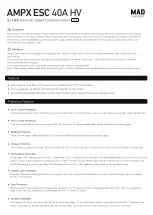
4
4. Press button (
D
) all the way in and hold, press
button (
C
) for the piezo igniter several times
to light the burner. This can be observed on
the flame indicator (
B
), on the refrigerator.
When the flame is on, the red indicator is in
the green field.
5. After the gas is lit keep button (
D
) pressed
for 10 seconds. Release the button (
D
) and
check that the RED indicator is in the GREEN
field. If the burner goes out, repeat the lighting
procedure.
6. To shut off the refrigerator, turn knob (
A
) to
“OFF” position.
230-240V OPERATION
Before operating the refrigerator, check that the voltage
stated on the data plate is the same as the main voltage
in use.
1. Turn thermostat knob (
E
) to its highest (cold-
est) position.
2. Set energy selector (
A
) to position “AC”.
3. To shut off the refrigerator, turn knob (
A
) to
“OFF” position.
12V OPERATION
Only operate your refrigerator on 12V when the engine of
the vehicle is running - otherwise your battery will soon
be discharged.
1. Set the energy selector (
A
) to position “DC”.
2. Note! There is no thermostat function on 12V
operation, the refrigerator works continuously.
3. To shut off the refrigerator, turn the knob (
A
) to
“OFF” position.
REGULATING THE TEMPERATURE
The position number refers to fig.1.
It will take a few hours for the refrigerator to reach normal
operating temperature. So we suggest you start it well in
advance of a trip and if possible store it with precooled
foodstuffs.
On 230-240V operation and LP gas operation the refriger-
ator is controlled by a thermostat and the thermostat knob
(
E
) should be set at 3-5. If a lower (colder) temperature is
desired set the thermostat to a higher figure.
On 12V operation the refrigerator works continuously.
TRAVEL CATCH
Make sure that the travel catch is engaged when the mo-
tor home / caravan is on the move.
USING THE REFRIGERATOR
DO NOT store explosive substances in the refrigerator,
such as cigarette lighter gas, gasoline, ether or the like.
FOOD STORAGE
Always keep food in closed containers. Never put hot
food in the refrigerator; allow it to cool first.
The frozen food compartment is intended for the storage
of frozen food and for making ice. Most kinds of frozen
food can be stored in the frozen food compartment for
about a month. This period of time may vary, however,
and it is important to follow the instructions on the indivi-
dual packages.
ICE MAKING
Fill the ice tray to just below the brim with drinking water
and place them on the bottom of the freezer compartment.
Ice will be made more rapidly if the thermostat is set at its
highest position (biggest circle), but be sure to move the
thermostat back to normal setting when the ice is formed;
the refrigerator might otherwise become too cold.
DEFROSTING
Frost will gradually accumulate on the refrigerating surfa-
ces. Each time the door is opened some of the cold air in
the refrigerator spills out and is replaced by warm moist
room air. As this air is cooled, the moisture is deposited
onto the evaporator coils or other cold surfaces inside the
refrigerator and can cause frost build-up.
It is important that you do not leave the unit’s door open
any longer than necessary. This will reduce frost forma-
tion and increase the efficiency of your refrigerator.
The frost must not be allowed to grow too thick as it acts
as an insulator and adversely affects refrigerator perfor-
mance. Check the formation of frost regularly every week
and when it gets about 3 mm thick, defrost the refrigerator.
Do not try to accelerate defrosting by using
any kind of heating appliance, as this might
damage the plastic surfaces of the refrigerator.
Neither should any sharp objects be used to
scrape off the ice.
CLEANING THE REFRIGERATOR
Clean the inside of the refrigerator regularly to keep it
fresh and hygienic.
Never use detergents, scouring powder, stron-
gly scented products or wax polish to clean the
interior of the refrigerator as they may damage
the surfaces and leave a strong odor.
Soak a cloth in a solution consisting of a teaspoon of bi-
carbonate of soda to half a litre of warm water. Wring out
the cloth and use it to clean the interior of the refrigerator
and its fittings.
z
P
m
K
Содержание RM 4601
Страница 12: ...12 APPENDIX A WIRING DIAGRAM...






























